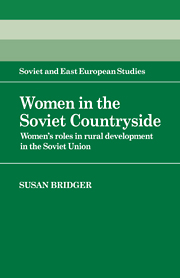Book contents
- Frontmatter
- Contents
- List of figures
- List of tables
- Acknowledgements
- Notes for readers
- Map: the Union republics of the USSR
- Map: the Non-Black Earth Zone of the RSFSR
- INTRODUCTION
- 1 WOMEN IN THE RURAL WORKFORCE
- 2 WOMEN IN THE RURAL FAMILY
- 3 WOMEN'S ROLES IN RURAL CULTURE
- CONCLUSIONS
- Notes
- Bibliography
- Index
3 - WOMEN'S ROLES IN RURAL CULTURE
Published online by Cambridge University Press: 05 January 2012
- Frontmatter
- Contents
- List of figures
- List of tables
- Acknowledgements
- Notes for readers
- Map: the Union republics of the USSR
- Map: the Non-Black Earth Zone of the RSFSR
- INTRODUCTION
- 1 WOMEN IN THE RURAL WORKFORCE
- 2 WOMEN IN THE RURAL FAMILY
- 3 WOMEN'S ROLES IN RURAL CULTURE
- CONCLUSIONS
- Notes
- Bibliography
- Index
Summary
EDUCATION
Since 1960 the improvement in the educational attainment of the Soviet population has been considerable. Even in the countryside, which has throughout the period suffered the loss of many of its ablest young people to the towns, attainment has increased significantly. By 1979, almost half the rural population over the age often had received some form of secondary education: nearly double the proportion in 1959.
An analysis of the structure of the rural workforce in terms of educational attainment (Figure 8) demonstrates most clearly the pattern of change during the 1970s. In 1970 more than half the women employed in rural areas of the USSR had received no more than primary education, whilst almost a fifth had not received even this amount of schooling. Figures recorded for rural men in this same year were not a great deal better. At the other end of the spectrum, however, the proportion of employed men and women who had completed their secondary education was roughly equal, whilst more women than men had received a higher or special secondary education. By 1979 the number of employed men and women with primary education or less had fallen significantly. At the same time the proportion of those with complete secondary education had doubled, reaching approximately 40% of the workforce.
- Type
- Chapter
- Information
- Women in the Soviet CountrysideWomen's Roles in Rural Development in the Soviet Union, pp. 155 - 216Publisher: Cambridge University PressPrint publication year: 1987

